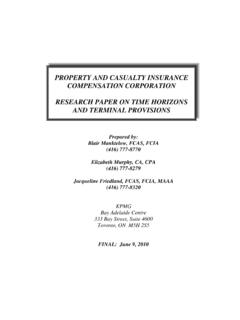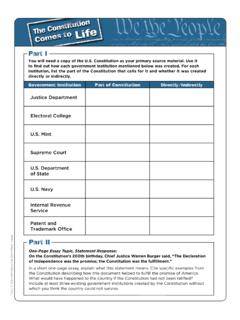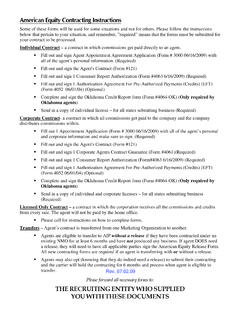Transcription of Inadequately pricing the promise of insurance - PACICC
1 Property and Casualty insurance Compensation Corporation Soci t d'indemnisation en mati re d'assurances IARD. Why insurers fail Inadequately pricing the promise of insurance Claims Premiums Years By Darrell Leadbetter Peter Stodolak 2009. Why insurers fail Inadequately pricing the promise of insurance By Darrell Leadbetter Peter Stodolak 2009. Contents PACICC 's mission and principles .. i Exhibit I: Data deficiency simulation .. 25. Executive summary .. iii Exhibit II: Price control simulation .. 26. Introduction .. 1 Exhibit III: Statistical results .. 27. A historical overview of insurance References .. 29. underwriting .. 3. Insolvency experience by jurisdiction .. 6. Inadequate pricing : the Canadian experience .. 7. Strategic decision-making and governance .. 8. Underwriting and risk selection .. 9. Reserving .. 9. New entrants.
2 9. Aggressive pricing practices .. 10. Analysis of corporate characteristics: inadequate pricing .. 11. Firm size and data deficiency .. 11. Managerial experience .. 12. Rate regulation .. 14. Statistical analysis of P&C insurance insolvencies .. 18. Literature review .. 18. Methodology and data .. 20. Discussion of results .. 22. Link to characteristics of Canadian involuntary exits .. 23. Summary .. 24. PACICC 's mission and principles Mission statement The mission of the Property and Casualty insurance Compensation Corporation is to protect eligible policyholders from undue financial loss in the event that a member insurer becomes insolvent. We work to minimize the costs of insurer insolvencies and seek to maintain a high level of consumer and business confidence in Canada's property and casualty insurance industry through the financial protection we provide to policyholders.
3 Principles J In the unlikely event that an insurance company becomes insolvent, policyholders should be protected from undue financial loss through prompt payment of covered claims. J Financial preparedness is fundamental to PACICC 's successful management support of insurance company liquidations, requiring both adequate financial capacity and prudently managed compensation funds. J Good corporate governance, well-informed stakeholders and cost-effective delivery of member services are foundations for success. J Frequent and open consultations with members, regulators, liquidators and other stakeholders will strengthen PACICC 's performance. J In-depth P&C insurance industry knowledge based on applied research and analysis is essential for effective monitoring of insolvency risk. i For every promise , there is a price to pay.
4 JOHN ROHNX AMERICAN ENTREPRENEUR , AUTHOR AND MOTIVATIONAL SPEAKER. Executive summary nsurance is a promise to pay claims in the future in exchange for premiums today. Confidence I in the industry rests upon the foundation that these claims will be paid. Over the past 30 years, inadequate pricing and reserving has been the leading cause of failure for Canada's insurers. What can we learn from the experience of 14 Canadian insurers that failed due to price inadequacy and deficient loss reserves? The leading cause of failure Since 1979, 32 insurers have been involuntarily wound-up by Canada's solvency regulators. Several (11 companies) were financially sound yet were closed because their foreign parent became insolvent. But most became insolvent (21 companies). Two-thirds of the insolvent Canadian insurers over the past 30 years failed due to inadequate pricing , deficient loss reserves or rapid growth (14 of the 21 companies).
5 Insolvency arises when insufficient assets and capital are in place to cover the claims liabilities incurred. A few insurance companies have failed over the last 30 years because of shocks to their capital or reinsurance arrangements (3 companies). One company failed because it was overwhelmed by claims from a catastrophic event. A few companies failed due to alleged fraud (3 companies). But two-thirds of the Canadian insurance failures over the past 30 years were due to some form of price or reserve inadequacy (14 companies). PACICC is Canada's national guarantee fund that protects insurance consumers from undue financial loss in the event that a member insurer fails. More than 75 percent of the claims paid by PACICC since it was founded were the result of insurers that failed due to price or reserving inadequacy. This is the third report in PACICC 's ongoing research into why insurers fail.
6 Our objective in this report is to focus on lessons learned from insurance failures due to severe price or reserving problems. We have identified five factors that have contributed to severe price or reserve inadequacy: insurance pricing is difficult Claims, the largest cost for insurers, are unknown when the customer is accepted. pricing is determined and agreed to before costs are known. Actuarial analysis is used to anticipate the expected frequency and severity of future claims but actual costs are not known when prices are set. Some have described this as an inverted production cycle, noting that insurance is quite different from the other financial industries and most businesses where input costs are largely known when prices are set. pricing under duress Troubled companies frequently assume additional risks when struggling to survive.
7 Distressed insurers sometimes enter into new markets where the risks are unfamiliar, and/or they temporarily offer aggressive pricing to attract customers and additional revenue. While there may be examples where gambling the company proved successful, often these approaches cause the situation to deteriorate rapidly. iii De-linking the relationship between claims costs and pricing increases insolvency risk Anything that systemically disrupts the link between pricing and expected claims costs increases the risk of insolvency. Experience in Canada and the United States indicates that stricter forms of rate regulation can weaken or even disrupt the price/claim link. Specifically, these stricter forms of rate regulation can reduce the capacity of insurers to make rate changes consistent with changes in underlying claims patterns.
8 As a result, an insurer may be forced to draw down its capital to support claims, possibly impairing its solvency strength in the process. Data deficiency and poor information management Most Canadian insurers that have failed due to price and reserve inadequacy had poor information management systems. The specific deficiencies varied, yet consistently failed to provide meaningful and timely information about claims costs needed to properly manage solvency risks. pricing is difficult in new markets North American data show that almost one quarter of new insurance companies fail within their first five years of operation and 70 percent of failed insurers were less than ten years old. Setting adequate prices is a challenge for inexperienced insurers, including new companies and established companies that enter into new markets.
9 Overall, our detailed case review of the Canadian insolvency experience and supplementary analysis of the United States experience relating to inadequate pricing has identified a number of relevant general observations: Governance and operational risk In many cases strategic decisions to enter new or unrelated lines lacked appropriate underwriting expertise and loss experience data. Prior to the wind-up of a company, management in many cases undertook strategies that could be described as gambling for survival.. Inadequate information and reporting processes and systems were found in 71 percent of involuntary exits linked to inadequate pricing . Costs of insolvency Inadequate pricing is the leading cause of failure among insurance companies. Insolvent insurers that underwrote rate-regulated products were more expensive in liquidation than other insolvent insurers.
10 Monitoring and supervision When industry growth in claims costs exceeds growth in capital, the probability of insolvency increases. Managerial experience in new entrants is an important determinant in the survival capacity of an institution. Companies writing in new lines of business, outside their area of expertise, are at greater risk. Price controls in a rate-regulated system that de-links the price/claim cost relationship are a risk factor for insolvency. iv Introduction he insurance industry is built on policyholder confidence that insurance contracts will be T fulfilled and eligible claims paid. This is the promise that insurers make to policyholders in exchange for premiums. For consumers, the purchase of insurance is a key component of how they manage their financial risk and consumer confidence in the industry is therefore closely linked to confidence in the solvency of their financial institutions.






